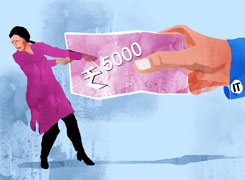Ramalingam Kalirajan |9758 Answers |Ask -Follow
Mutual Funds, Financial Planning Expert - Answered on Apr 30, 2024
He has an MBA in finance from the University of Madras and is a certified financial planner.
He is the director and chief financial planner at Holistic Investment, a Chennai-based firm that offers financial planning and wealth management advice.... more

Hi sir, I am 35 years old and below are my mf portfolio with 10% stepup annualy. My goal is to buy car of around 10Land sibling marriage help with 15- 20L in next 5 years. Currently I am investing around 7.6k monthly but can stretch it to 15k. Please let me know what changes do i have to do towards my goal. Or its ok? 1. Icici prudential bluechip fund=1k 2. Motilal oswal midcap fund=1.65k 3. Nippon india gold saving fund=1.1k 4. Parag parekh flexi cap fund=1.65k 5. Uti nifty 50 index fund= 1.1k 6. Nippon india small cap fund= 1.1k
Assessing Current Portfolio: Your current portfolio comprises a mix of bluechip, midcap, flexi cap, and small cap funds, along with a gold savings fund and an index fund. While diversified, it's essential to ensure that your investments are optimized for your specific goals.
Goal-Based Investing: Given your goal of purchasing a car and assisting with your sibling's marriage expenses in the next 5 years, it's crucial to prioritize stability and liquidity in your investments. Consider reallocating a portion of your portfolio towards debt or hybrid funds to minimize volatility and ensure capital preservation.
Increasing Monthly Investments: Since you have the flexibility to increase your monthly investments to 15k, consider diverting the additional funds towards debt-oriented mutual funds or recurring deposit schemes. This can help build a separate corpus earmarked for your short-term goals.
Rebalancing Portfolio: Review your existing funds and consider reallocating or reducing investments in high-risk funds such as midcap and small cap funds. Instead, focus on funds with a more conservative approach or those specifically designed for short-term goals.
Exploring Debt Instruments: Explore options such as debt mutual funds, liquid funds, or short-term bond funds for your short-term goals. These instruments offer relatively lower risk and greater liquidity, making them suitable for achieving goals within a 5-year timeframe.
Consulting a Financial Advisor: Consider consulting a Certified Financial Planner to develop a customized investment strategy tailored to your goals, risk tolerance, and investment horizon. They can provide personalized recommendations and guidance to help you achieve your financial objectives effectively.
By reassessing your portfolio, increasing monthly investments, and focusing on stability and liquidity, you can work towards fulfilling your goals of purchasing a car and assisting with your sibling's marriage expenses within the desired timeframe.
You may like to see similar questions and answers below
Hardik Parikh | Answer |Ask -Follow
Tax, Mutual Fund Expert - Answered on Apr 20, 2023
Ramalingam Kalirajan |9758 Answers |Ask -Follow
Mutual Funds, Financial Planning Expert - Answered on Apr 12, 2024
Ramalingam Kalirajan |9758 Answers |Ask -Follow
Mutual Funds, Financial Planning Expert - Answered on May 08, 2024
Ramalingam Kalirajan |9758 Answers |Ask -Follow
Mutual Funds, Financial Planning Expert - Answered on Jul 11, 2024
Ramalingam Kalirajan |9758 Answers |Ask -Follow
Mutual Funds, Financial Planning Expert - Answered on Nov 04, 2024
Nayagam P P |8978 Answers |Ask -Follow
Career Counsellor - Answered on Jul 17, 2025
Dr Nagarajan J S K |1851 Answers |Ask -Follow
NEET, Medical, Pharmacy Careers - Answered on Jul 17, 2025
Dr Nagarajan J S K |1851 Answers |Ask -Follow
NEET, Medical, Pharmacy Careers - Answered on Jul 17, 2025
Nayagam P P |8978 Answers |Ask -Follow
Career Counsellor - Answered on Jul 17, 2025
Nayagam P P |8978 Answers |Ask -Follow
Career Counsellor - Answered on Jul 17, 2025
Nayagam P P |8978 Answers |Ask -Follow
Career Counsellor - Answered on Jul 17, 2025
Mihir Tanna |1068 Answers |Ask -Follow
Tax Expert - Answered on Jul 17, 2025
Nayagam P P |8978 Answers |Ask -Follow
Career Counsellor - Answered on Jul 17, 2025
Nayagam P P |8978 Answers |Ask -Follow
Career Counsellor - Answered on Jul 17, 2025
Nayagam P P |8978 Answers |Ask -Follow
Career Counsellor - Answered on Jul 17, 2025






















